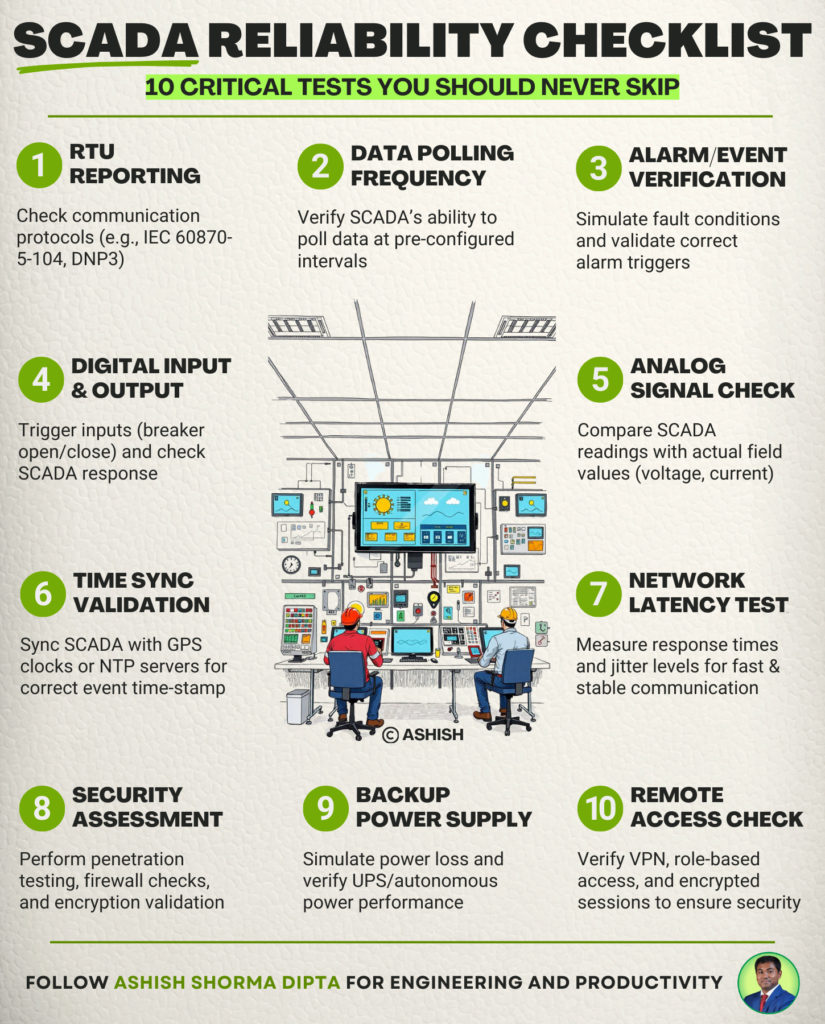Supervisory Control and Data Acquisition (SCADA) systems are the backbone of substation automation, enabling real-time monitoring, control, and protection of electrical infrastructure. However, even a single communication failure can disrupt an entire substation, leading to power outages, false alarms, or even complete system failure. Regular testing is not optional—it’s essential to ensure seamless operation and security.
10 Key Tests to Ensure SCADA System Reliability
To maintain a robust and fault-tolerant SCADA system, utilities must conduct periodic testing across multiple dimensions. Here are the ten critical tests every SCADA system should undergo:
1. RTU Communication Test
- Purpose: Ensures reliable data exchange between Remote Terminal Units (RTUs) and the SCADA master station.
- How to Test: Monitor data transmission between RTUs and SCADA, verify error logs, and test response time under normal and stressed conditions.
2. Data Polling Frequency Check
- Purpose: Prevents outdated readings by verifying data retrieval intervals.
- How to Test: Validate that polling rates match system specifications and adjust settings to optimize performance without overloading the network.
3. Alarm & Event Verification
- Purpose: Confirms alarms trigger correctly under fault conditions.
- How to Test: Simulate different fault scenarios and observe if alarms generate, log correctly, and trigger necessary responses.
4. Digital Input/Output (DI/DO) Test
- Purpose: Ensures field signals are properly mapped and processed.
- How to Test: Verify that field devices correctly send and receive digital signals in alignment with SCADA configurations.
5. Analog Signal Calibration
- Purpose: Prevents incorrect voltage, current, and power readings.
- How to Test: Compare SCADA-reported values against field-measured values and adjust calibration settings where discrepancies exist.

6. Time Synchronization Validation
- Purpose: Guarantees accurate timestamps for event analysis.
- How to Test: Compare timestamps across multiple devices and verify synchronization with GPS or network time servers.
7. Network Latency & Jitter Test
- Purpose: Identifies communication delays that can affect system response.
- How to Test: Measure round-trip communication times and analyze jitter patterns to detect inconsistencies in data transmission.
8. Cybersecurity Vulnerability Assessment
- Purpose: Detects security weaknesses in SCADA communications.
- How to Test: Perform penetration testing, inspect firewall and encryption settings, and evaluate access control mechanisms.
9. Backup Power Supply Test
- Purpose: Ensures continuous operation during power failures.
- How to Test: Simulate power outages to confirm SCADA and critical components transition smoothly to backup power sources.
10. Remote Access Functionality Check
- Purpose: Verifies secure and reliable remote monitoring/control.
- How to Test: Test remote login, validate encrypted communication, and check role-based access permissions.
Why These Tests Matter
Conducting these tests regularly brings significant operational benefits:
- Prevents false tripping & data loss – Avoids unnecessary outages and incorrect system actions.
- Improves real-time monitoring & control – Enhances decision-making and situational awareness.
- Enhances cybersecurity & operational efficiency – Strengthens defenses against cyber threats.
- Reduces downtime & maintenance costs – Ensures early detection of issues before they escalate.
Conclusion
A well-maintained SCADA system is crucial for a reliable and secure electrical grid. By implementing a rigorous testing strategy, utilities can minimize operational risks and optimize performance.
How often do you conduct these tests in your SCADA system? Let’s discuss your strategies in the comments below! Also visit my LinkedIn Page here to learn more.